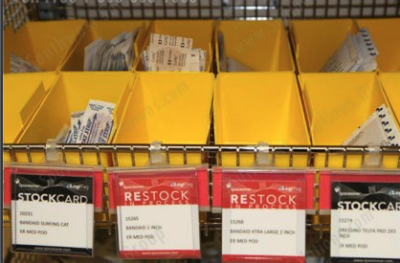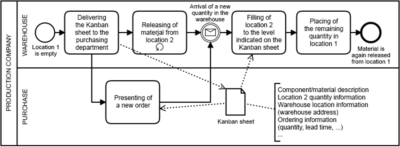An efficient and simple method of warehouse management – Kanban.
Author: Lauri Antalainen
Problems with warehouse management
Companies that have not yet digitalised their main processes, may often experience significant problems with the management of their warehouses, including not being able to fulfil deadlines promised to clients. For example, when stock of a component required for production has been depleted and production of the corresponding product cannot continue until the additional component or material has been ordered and received, leading to a longer delivery schedule which may prove time consuming.
In many industries, to minimise the associated risk, systems are put in place whereby the person responsible for production, the warehouse, or purchasing, visits the warehouse on a daily basis to ensure that there is sufficient stock of the most important materials. Such a “daily inventory” system, is, however, costly, can still cause problems, and is subject to human error. Another drawback of this system is that the amount of stock stored is often much more than optimally required, and this can lead to waste and the tying up of capital.
What is the Kanban system?
Fortunately, there is a simple yet effective method of bringing the management of a non-digitalised warehouse under control and reducing the average stock holding – namely, the Kanban Warehouse System. The main idea behind the Kanban Warehouse System is simple – the creation of a signal representing the need to augment stock. Such a signal is achieved by visually differentiating the so-called minimal stock (quantity ordered – minimum quantity) from the balance of the stock, which then triggers the ordering process when this stock is depleted.
In the Kanban System, to differentiate from the minimum and remaining stock of a component or material, two separate locations in close proximity to each other in the warehouse are used. The minimum stock, for example, can be stored on the bottom shelf (location 2) and the remaining stock on the top shelf (location 1). They can even be stored on the same shelf by placing a labelled sheet between the minimum quantity and the remaining quantity. The most common practice for smaller details is the use of two boxes or containers.

Figure 1. Kanban System – a new order for the component (in the given picture – medication), is triggered when the first box is emptied. The rear box contains the safety margin which is used until the ordered goods arrive. The rear box is filled to the established quantity foreseen first, and the remainder is placed in the first box.
Thus, it is important to think through which process is initiated when the labelling representing the minimal quantity is reached. There are many different possibilities here as well. The map representing the goods can be turned the other way around, as seen in the solution displayed in Figure 1 where the back of the map is red. This in turn signals the need to place an order to the responsible employee regularly visiting the warehouse. Another solution which is often used is when the sheet differentiating the two quantities becomes visible, the given sheet is taken to the office or purchasing department, and from there, a new order is raised.

How to apply the Kanban System?
When using the Kanban System, it is important to consider which components or materials it should be applied to. Also, the minimum quantities and quantities ordered should be determined, so that the minimum quantity that remains in the warehouse is sufficient for the waiting time of the delivery. This quantity may be different for each item, depending on the conditions of the supplier and the material used in production. The system must be flexible and readily adaptable.
A well thought-out established Kanban System is extremely efficient, minimising work interruptions caused by running out of stock, while at the same time, minimising the average stock. The system functions so well that I have seen s company in which, despite the digitalisation of the warehouse, the Kanban System that had previously been used was maintained for the standard components for the stock of half-finished goods.
I recommend considering the application of the Kanban System if there are no plans to digitalise the warehouse in the immediate future. If, in the near future, you are planning to digitise the company’s processes (including the warehouse management). the experienced Digiwise specialists can assist you in finding and implementing solutions suitable for your company. If you are interested, please contact us at info/at/digiwise.ee